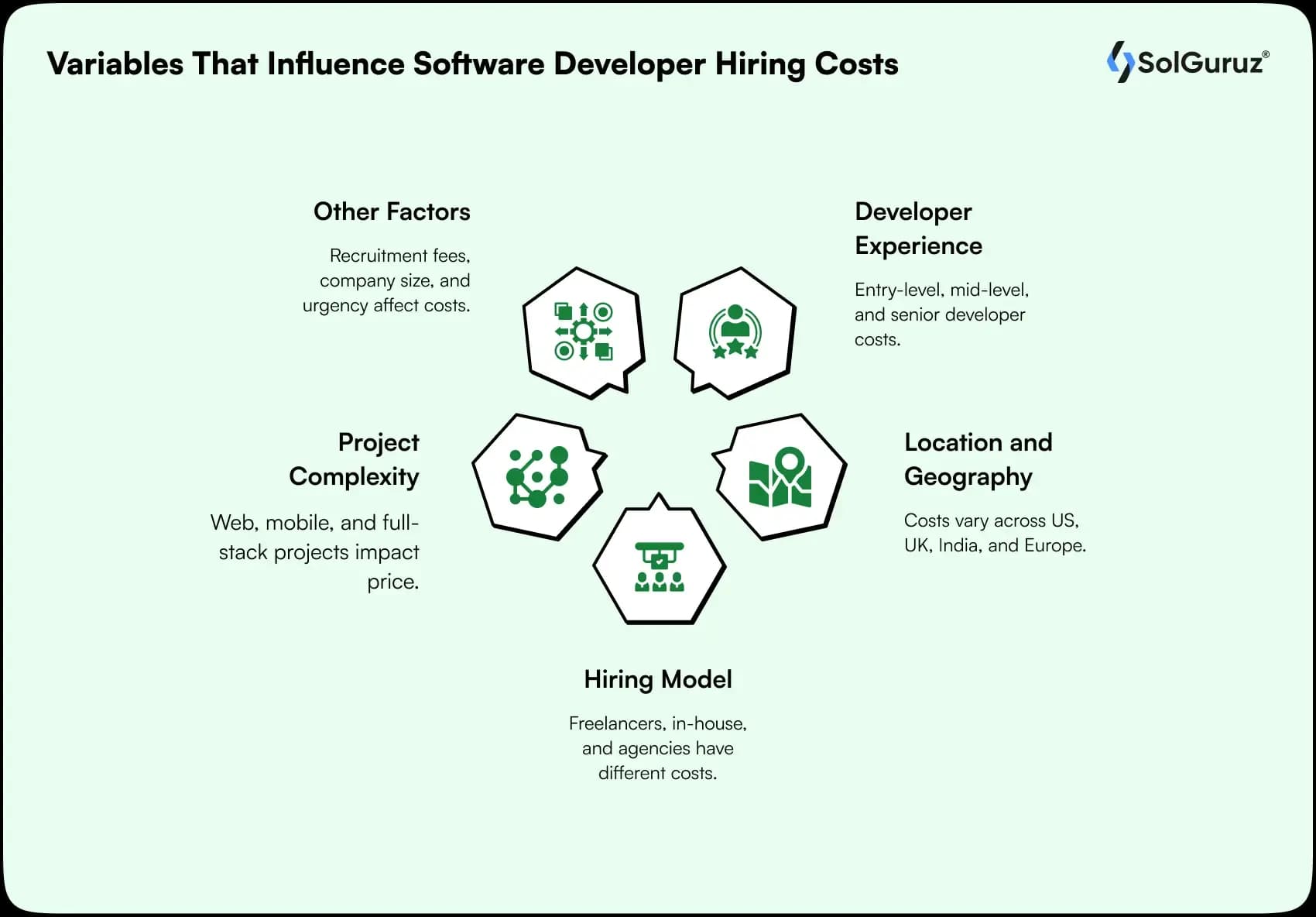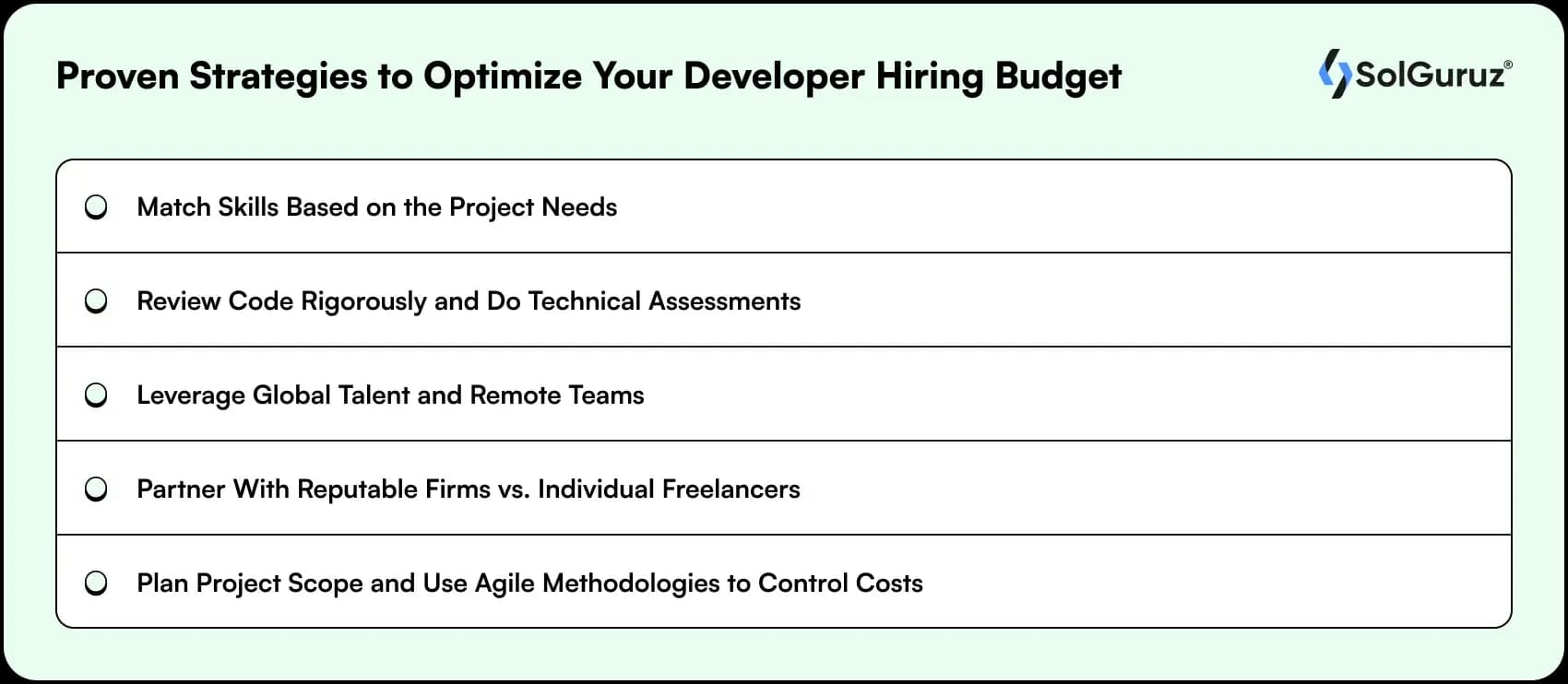How Much Does It Cost to Hire a Software Developer? [2025 Guide]
Hiring a software developer in 2025? This guide breaks down costs by region, experience level, and hiring model. Learn what affects pricing, hidden costs to watch out for, and smart strategies to stay on budget.

Hiring a software developer sounds simple—until you’re neck-deep in resumes, rates, and uncertainty.
You need someone skilled, dependable, and aligned with your project goals – but the market is scattered.
When it comes to cost, it seems like a fish market:
- Some developers charge $20/hr
- Others ask for $150+
- Agencies pitch premium packages
- Freelancers seem affordable—until quality becomes a concern
So, how do you know what’s actually worth paying for?
In this guide, we break down the real costs of hiring a software developer in 2025—from hourly rates to hidden expenses—so you can make a smart, budget-aligned decision without sacrificing quality.
Table of Contents
TL;DR – Cost to Hire a Software Developer
To find a skilled software developer, rates vary widely depending on experience, location, and hiring model. Here’s a quick overview of cost variations:
- Freelancers:
$15–$60/hr (offshore) – affordable but requires careful vetting
$40–$100/hr (US/UK) – better communication, higher rates - Agencies:
$18–$80/hr (offshore) – structured teams, good for startups
$100–$200/hr (US-based) – premium quality and project management - In-house hires:
$80K–$160K/year + benefits – full-time commitment, best for long-term needs
5 Variables That Influence Software Developer Hiring Costs

Hiring a developer isn’t just about the hourly rate—it’s about what’s behind that rate. Here are the five key variables that shape how much you’ll actually pay:
1. Developer Experience and Expertise
Not all developers are created equal. Entry-level devs can handle basic features but may struggle with architecture or scaling. Senior developers bring speed, strategic input, and cleaner code—but come at a premium.
- Entry-level: $15–$20/hr offshore, $40K–$70K/year in-house
- Mid-level: $20–$30/hr offshore, $70K–$110K/year in-house
- Senior-level: $30–$50/hr+ globally, $110K–$160K+/year in-house
Tip: Pay for seniority when the project complexity demands it. Otherwise, mix senior and mid-level to optimize costs.
2. Location and Geography
Where your developer is based significantly impacts the rate. Talent from North America or Western Europe costs more than equally skilled professionals in India or Eastern Europe.
| Region | Avg Hourly Rate |
| US/Canada | $70–$150+ |
| Western Europe | $60–$130 |
| Eastern Europe | $30–$70 |
| India | $15–$50 |
| Southeast Asia | $18–$60 |
| Latin America | $30–$60 |
Tip: Offshore doesn’t mean low quality—but it does mean you need strong vetting and communication.
3. Hiring Model
Different hiring approaches bring different price tags—and risks.
- Freelancers: Flexible and affordable, but reliability varies.
- In-house developers: Great for long-term needs, but costly (salary + benefits).
- Agencies/Outsourcing Firms: More expensive, but offer speed, structure, and full teams under one roof.
Tip: For MVPs or tight timelines, agencies can often deliver faster with less hand-holding.
4. Project Complexity and Tech Stack
What you’re building matters. A simple static website will cost far less than a full-stack, AI-integrated SaaS platform.
- Basic web app: Lower rates, fewer moving parts
- Mobile app (Flutter/React Native): Mid-range cost
- Custom software or enterprise-grade platforms: High complexity, senior devs needed
- Specialized tech (AI, blockchain, embedded systems): Niche skills = higher cost
Tip: Don’t over-engineer your MVP. Choose the right tech stack that gets the job done efficiently.
5. Other Factors That Add Up
A few often-overlooked variables can quietly inflate your hiring budget:
- Recruitment platform fees: Job boards, marketplaces, or agency commissions
- Urgency: Faster hires often come at premium rates
- Company size: Big brands often pay more for top-tier talent
- Project length & engagement type: Short gigs may cost more per hour vs. long-term contracts
Tip: Plan ahead! Rushed hiring is usually more expensive and riskier.
Cost Breakdown: What You Can Expect to Pay in 2025

Now that you understand what influences developer costs, let’s break it down by hiring model, region, experience, and project type. These estimates are based on 2025 market trends and reflect the most common pricing bands.
1. Based on the Hiring Model
| Hiring Model | Hourly Rate | Monthly (Approx.) | Best For |
| Freelancers (offshore) | $20–$60/hr | $3,200–$9,600 | Short-term tasks, MVPs |
| Freelancers (US/UK) | $40–$100/hr | $6,400–$16,000 | Specialized or part-time roles |
| Agencies (offshore) | $30–$80/hr | $4,800–$12,800 | End-to-end development, managed teams |
| Agencies (US-based) | $100–$200/hr | $16,000–$32,000+ | Premium projects, full ownership |
| In-house Developers | $80K–$160K/year + benefits | $7,000–$13,500/month+ | Long-term development, company growth |
2. Regional Breakdown (Monthly/Annual Approx.)
| Region | Hourly Rate | Monthly Cost | Annual Salary (Est.) |
| US/Canada | $70–$150+ | $11,000–$24,000 | $120K–$180K+ |
| Western Europe | $60–$130 | $9,000–$20,000 | $100K–$160K |
| Eastern Europe | $30–$70 | $4,500–$11,000 | $55K–$100K |
| India | $20–$50 | $3,000–$8,000 | $35K–$75K |
| Latin America | $30–$60 | $4,000–$9,000 | $45K–$90K |
| Southeast Asia | $15–$40 | $2,500–$7,000 | $30K–$60K |
3. By Experience Level
| Level | Hourly Rate | Monthly Estimate |
| Entry-Level | $20–$40/hr | $3,000–$6,000 |
| Mid-Level | $40–$80/hr | $6,000–$12,000 |
| Senior-Level | $80–$150+/hr | $12,000–$24,000+ |
4. By Project Type: Mobile, Web, Backend, Full-Stack
| Project Type | Estimated Cost Range |
| Basic Website | $2,000–$10,000 |
| Web App (CRUD-heavy) | $10,000–$30,000 |
| Mobile App (iOS/Android) | $15,000–$50,000 |
| Full-Stack SaaS Platform | $40,000–$100,000+ |
| AI/Data/ML Application | $50,000–$100,000+ |
Hidden and Indirect Costs to Consider
The developer’s rate is just the surface cost. Many businesses underestimate the indirect expenses that quietly inflate the total spend. Here’s what else you should factor in:
1. Recruitment and Onboarding Expenses
Hiring isn’t free. Whether you’re using job boards, recruiters, or internal HR, there’s a cost involved.
- Recruiting platforms & job ads: $300–$1,000+
- Recruiter fees: 15%–25% of annual salary
- Onboarding tools, background checks, paperwork: $500–$2,000
- US average hiring cost: $4,000+ per developer
Hidden impact: Even before coding starts, you’ve spent thousands just to bring someone on board.
2. Training, Ramp-Up Time, and Productivity Delays
Even experienced developers need time to get up to speed with your product, codebase, and tools.
- Ramp-up time: 2–4 weeks of lower productivity
- Internal team time: Existing staff must assist/troubleshoot early on
- Documentation gaps: Poorly documented systems = more delays
Hidden impact: Delayed timelines, longer feedback loops, and extra coordination hours.
3. Benefits, Taxes, and Long-Term Retention Costs
Especially with in-house hires, you’re not just paying a salary—you’re committing to a package.
- Benefits (US average): 25%–35% of base salary
- Payroll taxes, insurance, equity, hardware, workspace
- Retention costs: Raises, bonuses, upskilling over time
Hidden impact: A $100K salary could easily become a $130K+ annual cost.
4. Maintenance, Upgrades, and Post-Launch Support
Many projects need ongoing attention even after launch—bug fixes, security patches, feature tweaks.
- Typical annual maintenance: 15%–25% of original dev cost
- Support contracts or retainer-based costs
- Downtime risks if support isn’t in place
Hidden impact: Skipping maintenance can lead to costly firefighting later.
How to Choose the Right Hiring Model for Your Needs
Your ideal hiring model depends on your goals, resources, and technical setup. Here’s how to decide between freelancers, in-house developers, and agencies:
-
When to Hire Freelancers?
Best for: Small, budget-friendly projects or MVPs with short timelines.
Pros:
- Flexible and affordable
- Quick to hire
- Ideal for short-term needs
Cons:
- Quality and reliability can vary
- Limited project oversight
- May require close supervision
Go with freelancers when speed and cost matter more than long-term continuity.
-
When to Hire In-House Developers?
Best for: Long-term product development where full-time collaboration is needed.
Pros:
- Full control and team alignment
- Strong cultural fit
- Easier collaboration and ownership
Cons:
- High upfront and ongoing costs
- Slower hiring cycles
- Requires internal HR and infrastructure
Go in-house when software is a core part of your business and you need consistent, full-time commitment.
-
When to Hire an Agency or an Outsourcing Firm?
Best for: Startups or non-tech teams that need structured, end-to-end delivery.
Pros:
- Ready-made teams with management included
- Fast turnaround with less operational effort
- Easier to scale without internal hiring
Cons:
- Higher hourly rates
- Less control over individual contributors
- Risk of becoming dependent on an external team
Choose an agency when you want speed and accountability without building an internal tech team from scratch.
Decision Matrix: Cost, Control, Scalability, and Time-to-Hire
To help you with the decision-making, we went through the pattern of decisions and needs, and this is what we came up with.
| Factor | Freelancer | In-House | Agency/Firm |
| Cost | Low | High | Mid to High |
| Control | Moderate | Full | Limited |
| Time-to-Hire | Fast | Slow | Fast |
| Scalability | Limited | Limited | High |
| Project Oversight | Needs monitoring | Direct | Managed |
Proven Strategies to Optimize Your Developer Hiring Budget

Hiring a developer isn’t cheap, but that doesn’t mean you can’t be strategic. These proven approaches can help you control costs without sacrificing quality.
1. Match Skills Based on the Project Needs
Don’t overhire. You don’t need a senior architect for CRUD dashboards or landing pages.
- Use junior or mid-level devs for basic features
- Bring in senior devs only when architecture or scalability is involved
- Break down the scope and assign skill levels accordingly
2. Review Code Rigorously and Do Technical Assessments
Never rely solely on resumes or portfolios.
- Run real-world coding tasks or test projects
- Include peer reviews or technical interviews
- Use platforms like Codility, HackerRank, or custom GitHub tasks
3. Leverage Global Talent and Remote Teams
You don’t need to hire locally to get great results.
- Offshore developers in India, Eastern Europe, and LATAM offer strong value
- Time-zone overlaps and English fluency are better than ever
- Focus on communication and process, not just price
A $40/hr developer from the right offshore team may outperform a $100/hr local dev.
4. Partner With Reputable Firms vs. Individual Freelancers
For complex or long-term projects, hiring an individual freelancer is risky.
- Agencies bring stability, backups, and end-to-end delivery
- They have workflows, QA, PMs, and accountability built in
- Many now offer flexible monthly contracts or dedicated teams
You may pay more per hour, but you’ll likely pay less over the project lifecycle.
5. Plan Project Scope and Use Agile Methodologies
Scope creep = cost creep. Clear planning is your best defense.
- Define MVP features first — don’t build everything at once
- Use Agile sprints to deliver iteratively and stay on budget
- Prioritize features based on ROI and user feedback
Conclusion: Plan Smart, Hire Smarter
Code is cheap. Bad hiring decisions aren’t.
The real cost of hiring a software developer isn’t just in the rate—it’s in misaligned skills, unclear scopes, and wasted time. Choose smart from day one.
Whether you’re going for a freelancer, building an in-house team, or outsourcing the whole thing – clarity and strategy will save you more than cutting corners ever will.
FAQs
1. How long does it take to hire a developer?
It typically takes 2–6 weeks to hire a developer, depending on the hiring model. Freelancers can often start within days, while in-house roles may take a month or more due to interviews, assessments, and onboarding.
2. What’s the difference in cost between hiring locally vs. offshore?
Hiring offshore can reduce hourly rates by 40%–70%. For example, a US-based senior developer might cost $100–$150/hr, while a skilled offshore counterpart may charge $30–$60/hr with similar quality (if vetted properly).
3. What are the risks of hiring cheap developers?
Cheaper often means inexperienced or unreliable. Common risks include:
- Poor code quality
- Missed deadlines
- Communication issues
- Higher long-term costs due to rewrites or fixes
Always balance cost with experience and accountability.
4. How can I negotiate developer rates without compromising quality?
Be transparent about scope, timeline, and budget. Offer flexible hours or longer-term commitments in exchange for better rates. With freelancers or agencies, you can also start with a trial project before committing.
5. Are there cost savings in hiring remote developers from the same country?
Yes. Remote developers based in lower-cost cities or regions within your own country often charge less than those in tech hubs, while still offering time zone alignment and cultural fit.
6. How do I budget for ongoing maintenance after hiring a developer?
Plan for 15%–25% of the initial development cost annually for maintenance, bug fixes, updates, and security patches. This is especially important for live products or customer-facing applications.
Want to Build Custom Software?
Let’s discuss how we can make your idea a reality with the best software devs.

Strict NDA

Trusted by Startups & Enterprises Worldwide

Flexible Engagement Models

1 Week Risk-Free Trial
Give us a call now!

+1 (724) 577-7737


